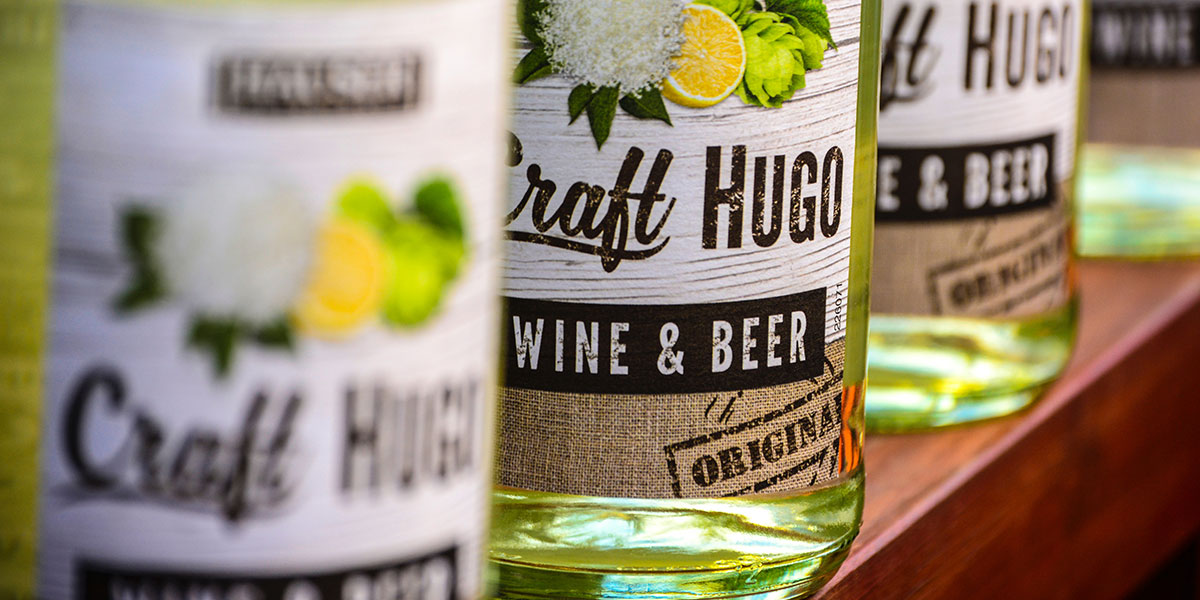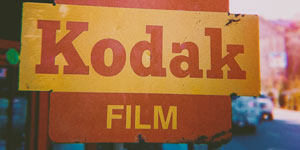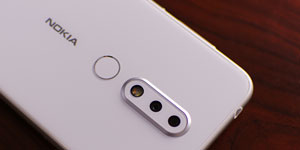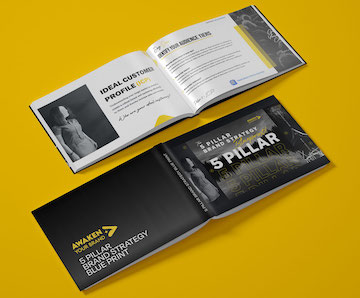As a business owner, you know the importance of delivering a high-quality product or service. But did you know that most companies have a gap between what they promise to consumers and what they actually deliver?
This is called the Brand Delivery GapTM.
As we will see, this gap can have devastating consequences.
In this post, we’ll look at this important facet of brand building, and we’ll look at how to close the dreaded brand delivery gap. You’ll learn how to make a brand promise you can keep and how to get started off on the right food by ensuring your visual branding is in line with your identity as a company. Read on.

What’s in A Brand?
The typical definition of a brand goes something like this:
It’s the sum psychological impact you make on customers, and it’s the relationship you build with them.
This somewhat stuffy definition sounds fine on paper, but what does it actually mean? What is it to have a strong brand, and why does it matter?
You could say that your brand is your voice. It’s the representation of your company, product or service.
On a practical level, it’s the sum of all your efforts to get your name out there. It’s the result of your branding and marketing—and it’s your customer’s opinion of you and your product. But before you can enjoy the benefits of a strong brand, you have to build one.
How do you do that?
What’s Required?
Building an awakened brand is a long-term effort consisting of several stages, though there is no specific sequence you must follow. But in order to create a robust brand, you will need a few things:
• Value proposition. You must know where your product stands in the market, what makes it different and why it’s superior. Your pricing should reflect your value, but it should also be in line with what the market is willing to pay.
• Innovation. To build a powerful brand, you need to bring something new to the market. McDonald’s didn’t invent the burger. But they did introduce an innovative drive-through system that allowed customers to order tasty food faster.
• Creativity. Everything about branding demands creativity. If you don’t have it, you’ll need to hire someone who does.
• Monitoring. Your brand is a living thing, existing in the headspace of your customers and the general public. It changes over time, and you’ll need to keep tabs on it. What do people really think about you, your product and your company?
• Customer service. This last one goes without saying. But to build an immense brand, you’ll need amazing customer service. This becomes more important as competition enters the marketplace. Even if you have an innovative product and you’re the first to market, you’ll need to treat your customers with respect.
Build Your Brand
Brand building is hard work done over time, involving a multitude of activities, but we can summarize the general steps.
#1. Describe your brand.
Who are you? What do you sell, a product or a service? A physical widget, or software? How is your product better than that of your closest competitor?
Consider Nike. Early on, they could have pinned everything on their shoes is the superior product, but through clever marketing and brand building, they instead created a legacy. They don’t just sell shoes, they sell an ego boost. For decades, sporting a pair of Nike sneakers on the court has meant something.
#2. Position yourself.
Once you know what you’re selling, the next step is to differentiate yourself from everyone else. McDonald’s focuses on quick service at a low price. Chick-Fil-A positions itself as the option for higher quality fast food. The same goes for Taco Bell and Chipotle Mexican Grill.
At the end of the day, both sell similar food, but they position themselves differently. Therein lies the key: they are telling their customers a story about who they are and what to expect from them.
#3. Promote yourself.
This involves, predictably, advertising yourself online, and in TV, radio or print. Today, many companies are embracing creative online advertising initiatives such as social media marketing and content marketing. These techniques call for a lower upfront investment but take longer to pay dividends. Yet, depending on your niche or industry, content marketing, in particular, can be an extremely effective means of brand building. Just ask HubSpot, Buffer, or surfing gear company, Rip Curl. Even GE has gotten in on the act, cleverly promoting their energy technologies on Instagram.
#4. Personalize.
The more your customers feel connected to your brand, the more effective your brand building will be. To this end, you must humanize your brand. Remind your customers every now and then that your product is produced by real, breathing human beings who take pride in their work. A strong “About Us” page on your site is a good place to start, but you can also use Instagram or a similar social media platform to show your staff at work and play. Consumers love to peek into the inner workings.
#5. Evaluate.
Finally, you’ll want to review the performance of your product or service. Continual evaluation and review are essential to brand building. Never be satisfied.

The Importance of Visual Branding
When it comes to building a brand, designing the logo and other visual elements is typically step three. Step one is research, and step two is to define the brand strategy, as we touched on above.
Yet too many companies either:
• Don’t spend enough time on step three.
• Or aren’t willing to spend enough money.
Your visual brand elements will be with you for a long time. What’s more, they help you stand out from your competitors. Don’t rush through this stage.
Similarly, it’s important when re-branding to think about your existing legacy. Think about how consumers will react to the changes you make. General Mills, the behemoth consumer food’s manufacturer, recently took flack for the redesign of their iconic logo. The logo design was, in fact, largely unchanged save for the addition of a red heart atop the iconic, stylized “G.”
Some have criticized the company for hoping the new logo design will create an association between General Mills and the American Heart Association. The American Heart Association’s logo design does, in fact, sport a large red heart as well. Some see the change as a cheap way to create an association between the company’s products and healthy living. This at a time when grains and other refined carbohydrates are coming under greater scrutiny.
As one critic put it, ‘We’re definitely getting vibes of Big Brother Loves You.’
When developing your story, company culture, core message, and brand promise, you need to think about your visual branding elements.
Simply put, creating visual branding elements that symbolize and support your message will help you build your brand faster. Additionally, your visual branding elements play into your brand promise.
Brand Identity
No matter how amazing your product is, your first and best chance to infiltrate the hearts and minds of consumers is with your visual branding and your brand identity. Your logo design and other visual elements lead the charge to establish your brand identity. They’re often the first contact point between you and a potential customer.
Let’s face it: people can be shallow. Keep this in mind when thinking about brand legacy and longevity.
Your logo design and other visual elements should represent you and your company in the best possible light. At the same time, they should say something about you, your values and your quality. Pulling this off is no mean feat. This is why professional logos sometimes cost thousands, hundreds of thousands or millions of dollars.
A good logo design will represent your company for years or decades to come. It’s more than the colors and design elements. An effective logo should be a reflection of your company, expressing the qualities you want to be known for. When designing your logo, you may find it helpful to think back to your customer personas. Think about their wants and needs, and then think about how your product satisfies those needs. How can you capture that in a logo?
A good logo should also be:
• Unique. Your logo should set you apart. As a newcomer, you don’t want to remind customers of your competition. Why should they go to you when they already know and trust your competitors? Show them why you’re different.
• Memorable. A quality logo is never forgotten. It’s instantly recognizable by consumers. The yellow double arches are famous around the world.
• Cohesive. All the design elements of your branding should complement one another. No element should be jarring. Everything should tie nicely together.

What is a Brand Promise?
All these elements come together to inform your brand promise.
But first, what exactly is it? And why do you need one? How does a brand promise make your business stronger?
A brand promise is not a slogan or headline. It’s not marketing copy. Nor is it your unique selling proposition. It’s not about benefits, and it’s not about selling the sizzle.
A brand promise is the articulation of the emotional outcome of your entire brand experience. It’s kind of like saying, We aim to please. Here’s how.
With your brand promise, you get to look beyond your profit agenda. You get to look at the deeper emotional connections you can forge with your customers.
As such, your brand promise should be an extension of your corporate strategy:
• Mission. What are you trying to achieve?
• Vision. Where do you see yourself in the market?
• Values. What do you bring to the table?
However, when thinking about the brand promise, you want to put yourself in your customer’s place. Think of the above elements from their perspective. How do your mission, vision, and values positively impact them?
Where is the overlap between your desire to earn a profit and their desire to fulfill a want or need? Within the overlap, you find your brand promise.
Put simply, then, your brand promise is your pledge to help your customers meet their needs.
Luxury brands fulfill their promise by offering exclusivity and providing an ego boost. Value brands do so by providing a product at a competitive price.
Why do You Need a Brand Promise?
Emotional resonance.
Companies that flesh out a clear brand promise resonate better with consumers. Consumers prefer to buy from companies with which they feel a connection. What’s more, this phenomenon has only grown stronger in the age of social media. Today, it’s the company that shows it has a heart that wins patronage, especially from millennials.
Additionally, a clear brand promise will focus your employees and give them a purpose beyond receiving a paycheck.
When employees feel their employers are about more than the bottom line, they’ll put more effort into their day-to-day work. Over time, this adds up. In fact, extraordinary things can happen when an organization embraces a strong purpose.
Your brand promise can provide employees with:
• Drive.
• Gratification
• Opportunities to collaborate with other departments.
• Greater fluidity and a break from routine.
• A chance to innovate and demonstrate expertise.
Bottom line: we now exist in the purpose economy. Everyone has a cause. Consequently, businesses must follow suit. It’s no longer enough to offer a widget, your widget must mean something. But hey, look on the bright side: your new purpose will light a fire under your employees.

Mind The Gap
All that said, most companies have a gap between their brand promise and their actual offering.
Management consulting firm Bain calls this the ‘delivery gap.’ In a recent study, Bain found that out of 362 companies analyzed, 80 percent believed themselves to offer a ‘superior value proposition.’ However, only 8 percent of customers agreed. That’s quite the gap.
Consider this, though: according to data from NewVoiceMedia, businesses in the U.S. are losing up to $75-billion per year due to low customer satisfaction. In 2016, this figure was only $13-billion, an increase of 37 percent.
According to the survey, the top reasons customers left were:
• Feeling underappreciated.
• Were unable to speak to a real, live person.
• Resented being passed around to multiple agents.
• Being put on hold for too long.
86 percent of participants said that if they had made an emotional connection with the business or customer service agent, they would have been more likely to return in the future.
Yet, according to the research, only 30 percent of customers feel any type of connection to a given business.
The data from NewVoiceMedia takes a somewhat narrow view of the customer experience. It focuses quite a bit on customer service itself. But the implications are clear: a gap between your brand promise and your actual performance will impact your bottom line.
An analysis conducted in the UK, entitled The Promise Index, looked at a brand’s image versus the actual customer experience. Each brand was given a Promise Gap score. Give this data a look if you have time. It’s quite enlightening.
The study defines the promise gap as, ‘…the difference between image and experience.’
The top brands were:
• Google
• Amazon
• PayPal
• Jaguar
• Singapore
• Freeview
• Marks & Spencer
• Sony
• Mercedes
• Emirates
Look into these brands to see what they’re doing right.
Why it Matters & How to Close the Gap
If your goal is to build a brand that will last, it’s hard to overstate the importance of minding the promise gap.
According to the firm Forrester, there is a direct correlation between customer satisfaction and loyalty. A customer who feels valued will return. A customer who feels their needs have not been met will not. This should be somewhat obvious, but damage to the brand image is not immediately apparent. It builds over time. Losing a customer here or there isn’t the end of the world, but allowing your reputation to erode could be.
According to a study conducted by RightNow in 2011, customers will pay up to 25 percent more for better customer experience. Remember, too, that it’s not just about customer service. Everything from product design, sales to post-sales support contributes to the customer experience.
Your marketing can serve as an advocate for both business and customer. Ensure your marketing is in line with reality. That is to say, don’t mislead consumers.
On the social media marketing side of things, strive to strike a balance between brand advocacy and self-promotion. Customers will tune out when all they receive from you are poorly disguised advertisements. But if you have an interesting story to tell about your brand, your employees or your company culture, they’ll listen.
Deliver what you promise and promise to deliver more as time goes by. Learn what your customers want, and offer as much personalization as you can. According to firm Accenture Interactive, in their 2018 Personalization Check report, 91 percent of customers are more likely to shop at locations that provide them with personalization options, such as relevant offers and recommendations.
Examples from History
Let’s dive into the annals of history to find instances of promise gap, shall we?
Kodak
 Kodak dominated the photographic film market for decades. But when it came time to innovate, Kodak missed the boat. In a real sense, they let their customers down. In so doing, they violated their brand promise to provide professionals, enthusiasts and casual users with the most up-to-date photography tools.
Kodak dominated the photographic film market for decades. But when it came time to innovate, Kodak missed the boat. In a real sense, they let their customers down. In so doing, they violated their brand promise to provide professionals, enthusiasts and casual users with the most up-to-date photography tools.
What changed?
Digital photography emerged in the late ‘90s, and Kodak scoffed at it. The real shame is that it was Steve Sasson, an engineer in the employ of Kodak itself, who invented the first digital camera way back in 1975. According to Sasson, because the technology didn’t require film, Kodak showed little interest.
When other companies advanced the technology in the ‘90s, Kodak management seemed to think it wouldn’t catch on. In fact, they didn’t think that digital photography would be disruptive at all. They thought it was a fad.
Kodak filed for bankruptcy in 2012.
Nokia
 Nokia was founded in Finland in 1865 as a mining operation. But today, the company is best known for the fact that it was the first company to establish a cellular network anywhere in the world. By the early 2000s, the company was the global leader in mobile phone manufacturing.
Nokia was founded in Finland in 1865 as a mining operation. But today, the company is best known for the fact that it was the first company to establish a cellular network anywhere in the world. By the early 2000s, the company was the global leader in mobile phone manufacturing.
But as the Internet became more relevant, Nokia held fast to the idea that hardware would be the primary driver of profits. This came at the cost of innovation, and the company failed to give the market what it wanted. Indeed, Nokia soon found itself pressed in on all sides by hungry competitors who were meeting the public’s demand for more sophisticated phones.
By the time Nokia did get around to creating an OS for their phones, it was inferior to what was on offer from other companies.
The company was relying on the strength of their brand to see them through a tough spot. But Android and Apple’s iPhone were what consumers wanted.
Xerox
 Xerox is another example of a company that seemed too big to fail—another example of what can happen if you become complacent. Xerox pioneered many of the technologies in the—now common—personal computer, but the company failed to profit from them. They assumed that consumers would be content to stick to simpler analog technologies, such as copy machines. CEO David Kearns was convinced that the more sophisticated digital communication tools the company’s R&D division had created wouldn’t catch on for some time.
Xerox is another example of a company that seemed too big to fail—another example of what can happen if you become complacent. Xerox pioneered many of the technologies in the—now common—personal computer, but the company failed to profit from them. They assumed that consumers would be content to stick to simpler analog technologies, such as copy machines. CEO David Kearns was convinced that the more sophisticated digital communication tools the company’s R&D division had created wouldn’t catch on for some time.
In the meantime, their competitors were racing into the digital age with glee, marketing these new products to the gadget-hungry masses.
Blockbuster
 Blockbuster peaked in 2004 after having survived the transition from VHC to DVD. After all, DVD is just another storage medium. DVD technology did not threaten their business model. But where Blockbuster failed was—and you might notice a pattern at this point—in that they failed to anticipate their customer’s wants and needs.
Blockbuster peaked in 2004 after having survived the transition from VHC to DVD. After all, DVD is just another storage medium. DVD technology did not threaten their business model. But where Blockbuster failed was—and you might notice a pattern at this point—in that they failed to anticipate their customer’s wants and needs.
The technology was advancing at a break-neck pace, and consumers didn’t want to physically go to a rental store if they could stream entertainment instead.
Enter Netflix.
What did Netflix do? They promised consumers to give them what they wanted, and then they did that.
Get this: in 2000, Founder of Netflix Reed Hastings went to former Blockbuster CEO John Antioco and proposed a partnership. Antioco refused the partnership, citing his belief that Netflix was a “niche” business.
Oh boy.
I hope this guide has helped you better understand the importance of closing the delivery gap. Know of any other companies that have failed in this department? Let me know in the comment’s section below!

